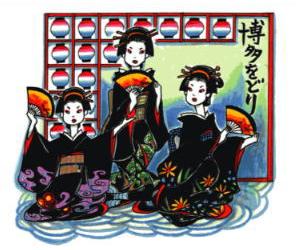Hakata Culture vol.26
Geisha to Grace Hakata-za's Stage

The Japanese term for the office in which geisha are hired is kenban. These offices are located all over the country, but the recent decline in the number of geisha has resulted in fewer requests for their services. The first kenban in Hakata opened in 1889, and by the early 20th century there were five of them here. During this heyday there were over 2,000 registered geisha in Hakata, but now there are only 18, ranging in age from their teens to their 80s.
The work of a geisha involves more than just appearing at private parties. The year for Hakata geisha begins from at the New Year’s festival held from January 8 to 11 at the Tokaebisu Shinto Shrine in Higashi Park, Hakata Ward. All the geisha gather for the Kachimairi ceremony on the 9th. They are truly a lovely sight to behold as they walk in their black-crested formal attire, Hakata obi, and hair pins designed to look like ears of rice.
They also participate in the Hakata Dontaku Minato Festival in May. On the 3rd and 4th they perform on shamisen and taiko drums, and sing and dance on stages located throughout Hakata. Once the Dontaku is over, they start practicing for the Hakata Odori in December. This is performed every December at the Hakata-za as one of the public performances in the Citizens’ Hinoki Stage Month. Upholding the traditional arts of Hakata, these geisha offer a complete performance of the arts they have perfected through daily practice. These include traditional music and dance forms including nagauta, kiyomoto (ballad-dramas), and tokiwazu (narrative music). The geisha practice assiduously for this event, as it is the culmination of their year’s work.
Following in the footsteps of Kyoto's Miyako Odori and Tokyo's Azuma Odori, the Hakata Odori was begun with the intent of preserving and passing on Hakata culture to succeeding generations. This year marks its 19th annual performance. In addition to dances that can only be seen in Hakata, the highlight of the event is the grand finale featuring all the geisha performing together. I hope all the people of Fukuoka take this chance to enjoy all the traditional arts of Hakata geisha, which are not often presented to the public.
A public relations manager
Kimiyo Sasaki
12月は博多座で芸妓さんの芸が見られます
芸妓さんが所属して、お座敷の取り次ぎを行なったりする事務所のことを券番といいます。全国各地にありますが、最近では芸妓さんの数が減り、声がかかるお座敷も少なくなって全国的に減少しています。博多に最初の券番ができたのは明治22年(1889年)、大正時代までに5つの券番ができました。当時は好景気に後押しされて料亭は大にぎわいだったといいます。けれども戦争で一時中断し、戦後いくつかの券番が復活しますが、最終的にはすべての券番がひとつにまとまって博多券番となりました。最盛期は2,000名を超える芸妓さんがいたそうですが、現在は18名、10歳代から80歳代までの芸妓さんが博多券番に所属しています。
芸妓さんの仕事は毎日お座敷に出ることだけではありません。博多芸妓の1年は、毎年1月8日~11日に行われる博多区東公園の十日恵比須神社の正月大祭で始まります。博多の芸妓衆が揃って1年の開運と商売繁盛を祈願するのが9日の「かち詣り」。黒紋付きの正装に博多帯、稲穂のかんざしをさして歩く姿は実に華やかです。5月は「博多どんたく港まつり」に参加。5月3、4日の2日間、博多芸妓は全員で博多の町の各所にある演舞台で、三味線、唄、太鼓、踊りなどの芸を披露します。
5月のどんたくが終わるとすぐに稽古に入るというのが12月に行われる「博多をどり」。現在は博多座で開催されていて、12月の「市民檜舞台の月」公演のひとつとして毎年行われています。博多の伝統芸能の担い手である芸妓衆が総出演し、日頃から磨いてきた長唄、清元、常磐津などの邦楽、邦舞の芸を披露します。いわば芸妓衆にとっては1年の集大成ともいえる舞台だけに、その練習にも力が入ります。博多をどりは京都の都をどり、東京の東(あづま)をどりに続いて、博多の伝統芸能を伝えていきたいという気持ちから始まったもので、今年で19回目を迎えます。博多ならではの踊りも披露しますし、芸妓衆が総出演するフィナーレが見どころです。めったに見られない博多芸妓の芸を、市民の皆さんも気軽に楽しんでください。
福岡市広報課長 佐々木 喜美代![]() 博多の芸妓ホームページ
博多の芸妓ホームページ

